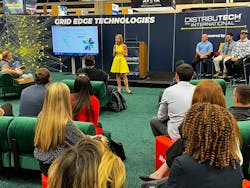Some questions are easier to answer than others when it comes to transforming the emissions impact of our energy actions.
We know decarbonization is the destination and renewables are one of the vehicles. Digitalization also is a key driver.
That’s just the start. How we get there is almost a maze at this point, according to the chit-chat at DISTRIBUTECH (DTECH) and POWERGEN International (PGI) last week in Dallas.
“The main messaging this year (at DTECH) is that changes are coming fast, and they’ll have massive impacts,” said Casey Werth, director of global sales, energy industry at IBM. “EVs and DER are two of the main drivers of this change.
“There is anxiety within some utility companies because they don’t see how to get started addressing the challenges coming their way,” he said. “IBM’s take is that utilities should look at the smaller parts of the bigger challenges… those parts that can be addressed immediately with current solutions that can start to make use of unleveraged data across IT and OT systems. This approach allows utilities to move forward with their immediate transformations while new technologies and solutions are being developed for future challenges.”
Jason Barmann, energy storage technology manager with engineering and construction firm Burns & McDonnell, had similar thoughts.
“We’re redesigning the entire power grid in a way it’s never been designed before,” Barmann said. “There are a lot of technologies needed for the future grid that maybe aren’t fully developed yet.”
Point A to Point B isn’t such an easy journey if net-zero is the goal by 2040. Those at DTECH-PGI clearly acknowledged the value of data and the tools needed to handle intermittencies, bi-directional flow, grid-edge pressure and beyond.
Yet data is the answer and the problem. Sensoring, metering, mapping and forecasting are helping immensely as the modern grid leaps into a new frontier. Artificial intelligence provides unwavering eyes on predictive needs like maintenance and operational flow.
Data, however, is both overwhelming and indispensable. Hate ‘em and datum.
“You need data, but the next step now is the need to integrate intelligence into operation systems,” said Anthony Allard, executive vice president head of North America for Hitachi Energy.
“What’s crucial?” he added. “Visibility in data is good, but you need to get something significant out of it.”
More than one of the experts T&D World editors talked to during the event noted that our grid faces enormous challenges in evolving from a centralized system run by utilities to a fast-growing and dispersed segment of generation resources on the edge.
Many leaders in this area are committed to the promise of a Net-Zero future full of rooftop solar, battery storage, microgrids and electric vehicles with plentiful charging infrastructure. And yet they fret because oftentimes control rooms and planners are lacking 100-percent accurate vision into what’s going on at the grid edge, such as when the wrong numbers of meters are mapped to the wrong transformer. Too much load hitting too small a system and zap, down it goes.
Acceleration of distributed energy is clearly a core part of future greening, but the screen goes black in chaos without vision.
“Our grid is being transformed from the outside in,” AutoGrid’s founder and CEO Amit Narayan said during the Schneider Electric press briefing this week on the DTECH exhibition floor.
Every residential unit, supplied with rooftop solar and EV charging or even a generator, has the ability to impact the grid, noted Kathy Shaffer, head of EnergyIP Product House at Siemens Smart Infrastructure USA. Installation of wind and solar power soared last year with some 33.6 GW added to the grid, according to media and industry outlets.
Solar capacity could triple by 2030, and that means millions of additional homes and hundreds of utility-scale projects. The microgrid industry, meanwhile, will aid in stretching the boundaries of the power system for many mission critical customers such as military bases, hospitals and data centers.
Consumers are becoming prosumers, both taking in energy, as well as giving it back for the benefit of the overall system. This sounds very egalitarian in theory, but dicey in practice.
The grid needs frequency regulation and steady resource to maintain inertia. It needs forecasting tools, sensoring and quick-response resources to handle ups and downs in weather-dependent generation.
“This is the next frontier,” said Stefan Zschiegner, vice president of product management for Outcomes at Itron.
“The time for grid upgrades and new (grid infrastructure) build could be years, therefore you need to find other solutions to bridge the gap and allow better grid management now,” Zschiegner added. “Regulators are not ready to approve projects for future demand. We’re not there yet.”
The U.S. is a grid with 50 or more different regulatory bodies and thousands of power generators. The rest of the world is not that different, if perhaps a little more unified on key challenges of our time.
All of us are facing an uncertain future. Climate change, political volatility, cybersecurity threats and technology disruption both known and unknown are sure to come. There are more questions than answers.
The solutions we have now may not be the end-all, be-all, but many are surely pointing the way. The time to begin was a long time ago and the journey must be taken together.
“Three things are essential: digitization; partnerships and decarbonization,” said Darryl Willis, vice president for energy at Microsoft. “You can’t do it without partnerships.”
Zschiegner echoed that, saying the energy transition is much bigger than one company and partnerships are essential.
It may be too late to limit rising temperatures at the current level, but removing 10 gigatons of carbon pollution is key to the hope for the future.
“We do believe it (climate change) is real and we believe decarbonization needs to accelerate,” Willis added.
Sponsored by IBM Corporation





